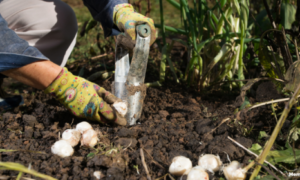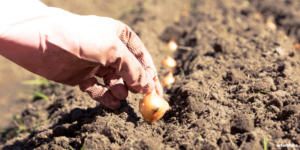It’s hard to say goodbye to the zinnias and roses and sunflowers of the summer season, or the tomatoes and zucchini of the vegetable garden. But just because the weather is cooling down doesn’t mean your green thumb needs to go into hibernation. Fall gardening can be just and vibrant and rewarding as spring and summer gardening, though some of it may require a little more patience.
What to Plant in the Fall

There are two major types of fall planting—plants that bloom and thrive during the fall, and plants that will be the first to come up in the spring.
Planting for Fall
When it comes to flowers and annuals that look beautiful in the fall and are able to survive dropping temperatures, chrysanthemums are possibly the most popular. With their fiery colors and cold-hardy temperaments, mums not only look beautiful and festive, they also last a long time. Other gorgeous fall annuals, great for both garden beds and containers, include coneflowers, pansies, flowering kale, black-eyed Susans, sweet alyssum, and ornamental peppers. The bright colors will liven up your balcony, porch, or garden beds all season long.
Fall is also a great time to squeeze a bit more life out of your vegetable garden. Some cold-hardy vegetables include lettuce, peas, cabbage, spinach, kale, cilantro, beets, radishes, cauliflower, and broccoli. If you’re planning on planting these veggies for fall, it’s best to start during late summer, but if you’re just getting to it now, you’ll probably still have some luck purchasing seedlings from a greenhouse or planting them in containers that you can take inside when the weather dips below freezing.
Planting for Spring

If you’ve ever looked at a neighbor’s garden in March and thought, ‘How the heck did they get so many beautiful flowers in the ground this early?’ then you’ve probably seen the work of a fall gardener. Fall is the perfect time to plant bulbs that will come up in the spring, like tulips, irises, daffodils, crocuses, grape hyacinths, allium, scilla, snowdrops, and other early spring blooms. Fall is also a great time to think about planting perennials like salvia, dianthus, or hostas, or shrub plants like hydrangeas or peonies. When you plant these in the fall, you’re giving the root systems time to develop and grow strong enough to survive the winter and provide you a stronger period of growth (and flowering!) than if you planted them in the spring.
You can also plant some root veggies in the fall, such as garlic, carrots, asparagus, leafy greens, or onions. Putting them in the ground early means you’ll be able to take advantage of spring as soon as it hits, and have a fantastic early harvest that is just as delicious as it is satisfying.
When to Plant in the Fall
There’s no one perfect date for fall planting in Colorado, because the climate at lower elevations differs drastically from the climate at higher elevations, and even from place to place, the season can vary dramatically.
Plant spring perennials at least six weeks before the ground freezes. This will give the plants enough time to establish a strong root system before they go into dormancy for the winter. When it comes to bulbs, six weeks before the ground freezes is also a good rule of thumb, though some bulbs can handle being planted a bit later. In general, plan on putting bulbs in the ground when nighttime temperatures start dropping to between 40 and 50 degrees—depending on where you live, this could be August or it could be mid-October. You want to give the bulbs enough time before the ground freezes for them to develop some roots, but not so much growing opportunity that they think it’s time to pop up out of the ground before winter hits.
How to Plant Bulbs

We plant spring bulbs in the fall because these guys need a period of cold in order to bloom in the spring. Without this period of cold, there’s nothing to spark the biochemical process that makes bulbs flower. (These aren’t to be confused with tender summer bulbs like dahlias, lilies, gladiolus, and elephant ears, which can be planted in the spring for a summer bloom, and aren’t tolerant of colder temperatures.)
Try to purchase your bulbs as close to growing time as possible, but if you buy them early, you can store them in a dark, dry place or even in your refrigerator until it’s time to put them in the ground.
When planting bulbs, an easy rule to remember is that they need to be planted about 2-3 times as deep as the length of the bulb itself. Make sure to put them in a place where they will receive lots of sun and good drainage, and plant them pointy-side up, which will help the roots grow downward. If you’re not sure which side is the pointy end, then plant the bulb on its side—the roots will probably figure themselves out. Bulbs like well-drained soil that is loamy or slightly sandy. Cover the bulbs with soil and mulch, and water regularly until it starts to get cold.
Pro tips: Lots of bulbs don’t flower for very long, so if you really plan ahead, you can plant them in clusters. Put some early-flowering varieties in the same areas as late-flowering varieties, or some taller tulips that flower later in front of shorter daffodils that flower earlier. This way you’ll get the most visual bang for your buck without having to do as much work.
Helping Plants Survive the Winter
Most flowers you plant in the fall don’t need a ton of help from you, and if you over-coddle them or overfertilize them, you could risk hurting the plant rather than helping it. But if you live somewhere the winters get very cold or very long—up at higher elevations, for example—there are a few things you can do to help give your garden the best chances of thriving through the winter. Insulating the ground with mulch or compost will provide a bit of extra warmth and shelter for your plants and their delicate roots during the cold months, and if you live somewhere with lots of critters like deer, you might also want to consider something a little more protective, like mesh, chicken wire, or bulb cages. Also, watering your garden regularly before the ground freezes can help those roots grow strong and deep, but once the cold really starts, it’s best to let nature do its thing without any interference from you.
The Benefits of Fall Planting
Fall planting is the ultimate form of gardening for planners. It takes patience, because the results won’t be seen right away, but as soon as spring hits, you’ll have a garden that will make all your neighbors jealous. If you plan it right, your time spent planning your garden in the fall can lead to perennial blooms year after year for a truly gorgeous garden that will make you smile every spring.
By Emily Krempholtz
